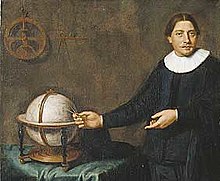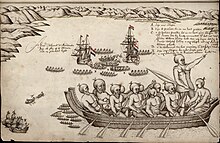Abel Tasman

Abel Janszoon Tasman (* 1603 in Lutjegast , Province of Groningen , † October 10, 1659 in Batavia , Java ) was a Dutch navigator . On his voyages of discovery he circumnavigated the Australian continent and was the first European to reach New Zealand on December 13, 1642 .
According to him, the Australian island of Tasmania (previously Van Diemen's Land ), the Australian Tasman Peninsula , the Tasman Sea between Australia and New Zealand, the Tasman Lake and the Abel Tasman National Park , the Tasman Glacier and the Tasman Bay in New Zealand as well the asteroid (6594) named Tasman .
Life
Living in the Netherlands
Abel Janszoon Tasman was born in 1603 in the village of Lutjegast ( Grootegast municipality ) in the Netherlands . Little is known about his childhood and youth.
The first recorded record is Abel's marriage to Jannetje Tjaerts in 1632. He was already a widower and had his second marriage. From his first marriage he had the daughter Claesgen. At that time Tasman was living in the Amsterdamer Straße Teerketelsteeg as a vaerentgesel (sailor).
Expeditions
A year later, Tasman hired the Dutch East India Company ( Vereenigde Oostindische Compagnie , VOC ). He signed a three-year contract and immediately sailed east.
When his second contract was signed in 1638, this time for ten years, Tasman was already entrusted with command of the ship Engel . His wife accompanied him on this trip to Batavia , today's Jakarta . In 1639 he drove to Japan with Matthys Quast and from there eastbound, probably touching the Bonin Islands for the first time .
In 1642 the Dutch East India Company decided to explore Australia (see also History of Australia ) through a planned expedition.
Tasman's first task was to find a short sea route into the Pacific to the "gold country Chile", furthermore to explore Australia, then known as New Holland , whose west coast the Dutch had previously discovered, and to determine whether it was part of the presumed continent Terra Australis . The Dutch East India Company hoped that this would open up new trading areas.
On August 13, 1642 Tasman therefore set out from the trade base in Batavia to explore the sea south of Indonesia for the legendary continent called Terra Australis Incognita. The expedition had two ships, a small warship of 60 tons called the "Heemskerck" with a crew of 60 and a narrow three-masted ship of 100 tons and a crew of 50, called the "Zeehaen". The famous helmsman and cartographer Frans (Franchoys) Jacobszoon Visscher was also on board . (The "Heemskerck" was named after the Dutch town of Heemskerk , possibly also after Captain Jakob van Heemskerk , who, together with Willem Barents , undertook an Arctic expedition from 1596–1598 to explore a north-eastern passage to China.)
First he sailed westward from Batavia to Mauritius to pick up wood, and from there on October 8 further south than previous Dutch expeditions to the east. As a result, he completely missed Australia, but reached land with the island of Tasmania for the first time on November 24, 1642 , which he did not recognize as an island. He initially named the country Van Diemens Land , after Antonio van Diemen , the then Governor General of the Dutch East Indies . However, the later British colonialists named them after Tasman.
From Tasmania they sailed further eastwards and on December 13th were the first Europeans to see New Zealand on the west coast of the South Island, between today's places Hokitika and Ōkārito . He called the country a state country. Tasman was not initially sure whether they had come across the already discovered west coast of today's Chile , but this was finally clarified a few months later and confirmed the new discovery of New Zealand.
Tasman's diary entry that day was:
“We gave this country the name States Land, in honor of the High Majesty the State General, because it could well be that this country adjoins States Land [today's Chile], although this is not certain. The country seems to be a beautiful country and we trust that this is the mainland coast of the unknown southern continent. "
Five days after this discovery, the expedition decided to go ashore for the first time, also because their water supplies were running low. To do this, they looked for a suitable anchorage, which they also found in today's Golden Bay .
The night after the first scouting with two small boats, Tasman had the first contact with the Māori . When the first attempts at communication failed and the following day the Dutch were unable to speak to the Māori who had come in canoes, they attacked a dinghy that was carrying messages between the expedition ships. They killed 4 sailors and rowed ashore with one of the bodies.
When Tasman saw that the locals, gathered in large numbers on the shore, were planning a major attack, he withdrew from the bay with cannon fire. He originally called the bay Moordenaers Baij - " killer bay ".
Frightened by this incident, the expedition refrained from further shore leave and sailed north along the coast. Tasman anchored again on the northernmost tip of the North Island of New Zealand and named Cape Cape Marie van Diemen after the wife of the then Governor General of Batavia. The islands in front of it were named the Three Kings Islands because Tasman discovered them on this holiday, January 6th.

Without taking the opportunity to set foot on New Zealand's main islands, Tasman sailed further north and discovered the Tonga and Fiji Islands in 1643 . On April 1, he stumbled on the northeastern edge of the Bismarck Archipelago with his expedition and then returned to Jakarta on June 14, 1643.
Tasman's clients were by no means satisfied with the expedition. As merchants, they were interested in trading goods and mineral resources (gold and silver). After the "Killer Bay" disaster, Tasman had barely explored on land. In addition, he had not clarified whether New Guinea and Australia are connected or whether passage is possible there.
In 1644 the company sent him out again - on the one hand to clarify the question of the passage, and on the other to map the northwest coast of Australia - the region now known as Tasmanland - and to locate natural resources and natural resources. This time Tasman took three ships and sent one straight to the Gulf of Carpentaria . The passage was not discovered. The question remained unanswered for over 100 years. It was only James Cook who rediscovered Torres Street . Another expedition to New Zealand was planned, but was canceled due to the renewed outbreak of war with Portugal .
This time, too, the yield was low. Tasman had not discovered valuable mineral resources. He was a good seaman and cartographer, but voyages of discovery on land obviously seemed too dangerous to him. So it stayed with the survey of the coasts.
Further life
At the end of 1644 Tasman was given an honorary post as a member of the Batavia Court of Justice for 4 years. There he was responsible for examining logbooks. In 1646 he was sent to Ceylon to evaluate the trade routes of Dutch ships. In 1647 he went to Siam (the old name of Thailand ) to buy goods and to give company gifts to the king. In 1648 he was sent to the Philippines as the commander of 8 warships to disrupt the Spanish trade and attack their bases. The campaign was partially successful.
An incident on this voyage brought him to court, where he lost his rank and salary for a year and also had to pay pain and suffering to a young sailor whom he had threatened with death when he was drunk. After that he only got smaller jobs. Due to illness, he soon withdrew.
Tasman died in 1659 at the age of 56. His estate, part of which he donated to the poor in his village, was mainly divided between his wife and daughter from his first marriage.
His work as a discoverer was recognized while he was still alive. After 1648 new maps and a globe in which his cartographies were entered appeared in Amsterdam. A concert march was also named after him.
literature
- Friedrich Ratzel : Tasman, Abel Janszon . In: Allgemeine Deutsche Biographie (ADB). Volume 37, Duncker & Humblot, Leipzig 1894, pp. 404-407.
- Friedrich, Herbert: Dorado or unknown southern country. Berlin, Verlag Neues Leben 1974. An exciting novel about the life of Daniel Hillebrant, husband of Tasman's daughter Claesgen, which also includes Tasman's travels.
- Andrew Sharp: Voyages of Abel Janzoon Tasman. Oxford University Press, Oxford 1968, ISBN 978-0-19-821536-3 .
- Tasman, Abel Janszon: Discovery of New Zealand, Tasmania and the Tonga and Fiji Islands 1642–1644. Tübingen, Edition Erdmanns Verlags GmbH, 1982. Later licenses: Darmstadt, Wissenschaftliche Buchgemeinschaft and K. Thienemanns Verlag, Stuttgart.
Web links
- Investigations into Tasman's diary entries ( Memento from June 21, 2002 in the Internet Archive )
- Discovery of an Explorer. In: Süddeutsche Zeitung . November 29, 2006.
- Literature by and about Abel Tasman in the catalog of the German National Library
| personal data | |
|---|---|
| SURNAME | Tasman, Abel |
| ALTERNATIVE NAMES | Tasman, Abel Janszoon |
| BRIEF DESCRIPTION | Dutch navigator and explorer |
| DATE OF BIRTH | 1603 |
| PLACE OF BIRTH | Lutjegast , Groningen |
| DATE OF DEATH | October 10, 1659 |
| Place of death | Batavia , Java |


